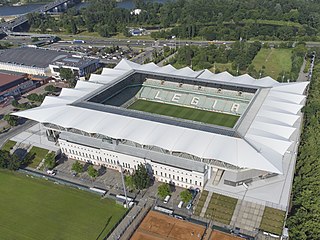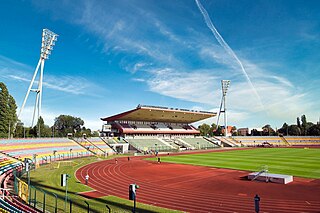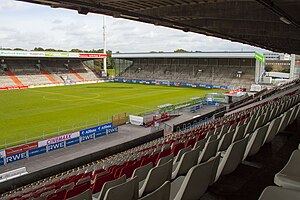
Ullevaal Stadion is an all-seater football stadium located in Oslo, Norway. It is the home ground of the Norway national football team, and the site of the Norwegian Cup Final. From its opening in 1926 to 2009 it was the home ground of FK Lyn and from 1999 to 2017 was a home ground of Vålerenga IF. With a capacity of approximately 28,000, it is the largest football stadium in Norway. The national stadium is fully owned by the Football Association of Norway (NFF).

The Olympiastadion, also known in English as the Berlin Olympic Stadium or simply the Olympic Stadium, is a sports stadium at Olympiapark Berlin in Berlin, Germany. It was originally designed by Werner March for the 1936 Summer Olympics. During the Olympics, the record attendance was thought to be over 100,000.

Stadion Feijenoord, more commonly known by its nickname De Kuip, is a stadium in Rotterdam, Netherlands. It was completed in 1937. The name is derived from the Feijenoord district in Rotterdam, and from the club with the same name.

The Philips Stadion is a football stadium in Eindhoven, Netherlands. As the home of PSV Eindhoven, it is therefore also known as PSV Stadion. With a capacity of 36,500, it is the third-largest football stadium in the country. Established as the Philips Sportpark, it was constructed as a sports field for Philips employees in 1910. The Philips Elftal played football matches from 1911 until 1913, when the team was succeeded by PSV. Since 1913, PSV has used the original ground as its home stadium.

Maksimir Stadium is a multi-use stadium in Zagreb, Croatia. Named after the surrounding neighbourhood of Maksimir, it is one of the largest stadiums in the country with a current seating capacity of 25,912 and a maximum possible capacity of 35,423. It is the home stadium of Croatian club Dinamo Zagreb and has been used since 1990 by the Croatia national football team for the majority of international competitions.

The Olympic Stadium is a sporting venue which was used as the main stadium for the 1928 Summer Olympics in Amsterdam. The venue is currently used mostly for athletics, other sports events and music concerts.

Rot-Weiss Essen is a German association football club based in Essen, North Rhine-Westphalia. The club plays in the 3. Liga, at the Stadion an der Hafenstraße.

Wuppertaler SV is a German association football club located in Wuppertal, North Rhine-Westphalia. The city was founded in the year of 1880 by the union of a number of smaller towns including Elberfeld, Barmen, Vohwinkel, Cronenberg and Ronsdorf – each with its own football club. Wuppertal Sport Verein was formed on 8.July 1954 out of the merger of TSG Vohwinkel and SSV Wuppertal and was later joined by Borussia Wuppertal to form the present day club. In addition to the football side, today's sports club includes departments for boxing, gymnastics, handball, and track and field.

Stade Geoffroy-Guichard is a multi-purpose stadium in Saint-Étienne, France. It is used primarily for football matches, and tournaments such as the UEFA Euro 1984 and 2016, the 1998 FIFA World Cup and the 2003 FIFA Confederations Cup. It is also used for rugby union, and was a venue at the 2007 Rugby World Cup. It is nicknamed "le Chaudron", or "l'enfer vert", an allusion to the colours worn by the local football team, AS Saint-Étienne, given during the team's heyday when it drew particularly large crowds. More recently, its current capacity was 35,616 before the current renovations, which began in 2011, and temporarily reduced this figure to 26,747. Since the renovations finished, the stadium holds 42,000 seated spectators.
Südweststadion is a multi-purpose stadium in Ludwigshafen am Rhein, Germany and was built in 1950, at which time it could hold 41,383 people. After a renovation in 2007, the maximum capacity was limited to 6,100 people. It is currently used mostly for football matches and is occasionally used as the home ground by FSV Oggersheim. The stadium has hosted several important games, such as four international matches of West Germany, two West German Cup finals and the Bundesliga championship match.

Malmö Stadion, often known simply as Stadion before the construction of the new Stadion between 2007 and 2009, is a multi-purpose stadium in Malmö, Sweden. As of 2015, it is the home of association football club IFK Malmö, presently of Division 2, and athletics club MAI. The stadium served as the home ground for Malmö FF, an association football team in Sweden's top flight, Allsvenskan, from its opening in 1958 until 2009, when the club moved to the newly constructed Stadion, built beside Malmö Stadion, in 2009. Malmö FF still use the stadium for training purposes and youth matches. Besides being used for sports, the stadium has also hosted various concerts and other events. The ground's record attendance, 30,953, was set in the first match played at the ground, a 1958 FIFA World Cup match between Argentina and West Germany.

The Rat Verlegh Stadion is a multi-purpose stadium in Breda, Netherlands. The stadium is the home of the association football club NAC Breda. It was formerly known as FUJIFILM Stadium (1996–2003) and Mycom Stadium (2003–2006), named after two former NAC sponsors. In 2006 NAC Breda named the stadium after its most famous NAC Player, Antoon Verlegh.

The Polish Army Stadium, official named the Marshall Józef Piłsudski Legia Warsaw Stadium, is an all-seater, highest fourth category football-specific stadium located at 3 Łazienkowska Street in the Śródmieście district, Powiśle area, within the square of the streets: Łazienkowska, Czerniakowska, Kusocińskiego and Myśliwieck. It is the home ground of Legia Warsaw football club, who have been playing there since 9 August 1930.

The Friedrich-Ludwig-Jahn-Sportpark is a multi-purpose sports complex located in the western part of the locality of Prenzlauer Berg in the borough of Pankow in Berlin. The sports complex covers an area of approximately 22 hectares and comprises several facilities. The main building is the Friedrich-Ludwig-Jahn-Stadion. The stadium is the third-largest stadium in Berlin, after the Olympiastadion and the Stadion An der Alten Försterei, with a capacity of approximately 20,000 seats, of which 15,000 are covered. The most recent main tenants of the stadium have been VSG Altglienicke and Berlin Thunder. Friedrich-Ludwig-Jahn-Sportpark was the venue for the 2018 World Para Athletics European Championships. The large stadium is planned for a complete redevelopment. Demolition of the stadium began on 8 October 2024.

Niederrheinstadion or Stadion Niederrhein is a multi-purpose stadium in Oberhausen, Germany. It is currently used mostly for football matches and is the home stadium of Rot-Weiß Oberhausen. The stadium currently has a capacity of 21,318 spectators.

Rudolf-Harbig-Stadion is a stadium in Dresden, Saxony, Germany. It is named after athlete Rudolf Harbig and is the current home of Dynamo Dresden. It also hosts fixtures of the German national team on an irregular basis since 1911. The stadium also hosts events outside association football, most notably as the home of the Dresden Monarchs American football team that play in the German Football League. Sports facilities have existed on the site of the stadium, the Güntzwiesen, since 1874.

The Rajko Mitić Stadium, previously known as Stadion Crvene zvezde, also known as Marakana, is a multi-use stadium in Belgrade, Serbia which has been the home ground of Crvena zvezda since 1963. The stadium is located in Dedinje, municipality of Savski Venac.

Stadion an der Hafenstraße, known as Stadion Essen until 2022, is a stadium in Essen, Germany. Located in the borough of Bergeborbeck, it has a capacity of 20,650 spectators. It is the home of Rot-Weiss Essen in the third-level men's 3. Liga and SGS Essen in the women's Frauen-Bundesliga and replaced Georg-Melches-Stadion.

Donauparkstadion, commonly known as Hofmann Personal Stadion for sponsorship reasons, is a stadium in Lustenau, a quarter of the city of Linz, Austria. It is currently used for football matches and is the home ground of Blau-Weiß Linz. The stadium holds 5,000 people from 2023–24 after renovation.
Moussa Doumbouya is a Guinean professional footballer who plays as a centre-forward for German 3. Liga club Rot-Weiss Essen.



















